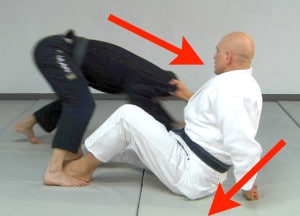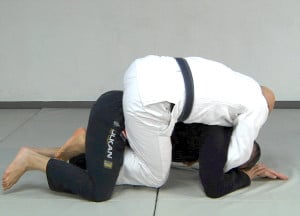So there you are, on your back and fighting your opponent with your legs. Maybe you’re using the Spider Guard, the Butterfly Guard, or any other variation of Open Guard, but regardless, both you and he are jockeying for grips and position.
You’re trying to set up your guard sweeps and submissions, and he’s trying to pass your guard.
Then – disaster!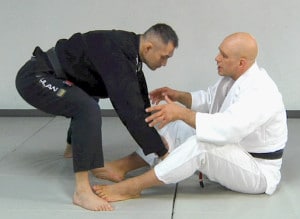
Your opponent grips both your pant legs and pins your legs to the floor. It’s almost like he’s doing a push-up on your legs, which kills almost all of your lower body mobility.
This is now an open guard emergency.
You’re now about a half second away from getting your guard passed.
He’s using his weight to pin your legs, and is either a) going to sprawl his legs and hips back and then hop around to side control using quick left-right motions, or b) bring one leg forward in a semi-circle and end up in knee mount. Both of these techniques are variations of a common, powerful guard pass called the Toreando Pass (also known as the Matador or Bullfighter Pass).
The Toreando is often one of the first guard passes that starts to work for beginners, and also one of the ones you see most often at the world championship level. It’s a serious threat that needs to be responded to immediately.
Alright, somehow your opponent managed to control your legs and pin them to the floor. What do you do now?
This is jiu-jitsu, and that means that there is almost always a way out of your predicament. Dealing with, shutting down, and countering the Tornado is the subject of the rest of this article.
Here are the three responses that I use most often in this situation…
Toreando Counter 1 – The Forearm Chop
This is the simplest solution, and I use it all the time.
Here are a couple of pics from the grips, hooks, posture and movement section of the 7 Days to Better Guard Sweeps app that illustrate the Forearm Chop technique.
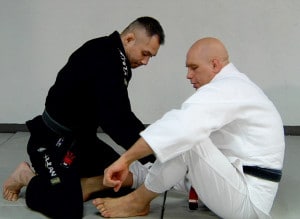
Let’s say you want to strip your opponent’s right grip on your left leg first. First make a fist with your left hand, your thumb pointing in towards yourself…
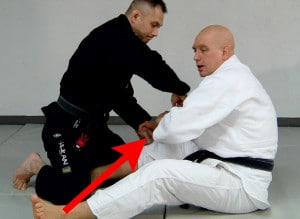
…then use the forearm of that hand to chop up along your own shin. The impact of your forearm bends his wrist, weakens his grip, and removes his control of your leg.
You can amplify the effect by kicking your leg straight at the moment of impact, but that’s not always necessary.
This is a quick, efficient motion. If necessary you can do the exact same thing with your other arm to remove his second grip on your right leg.
The forearm chop solves the immediate emergency, but I’ve seen a lot of people make the mistake of only using this move one time.
Their opponent grabs and pins their leg, which they successfully successfully defend by chopping off the offending grip. But then they rest on their laurels while theguy on top simply reaches out and secures the exact same grip a second time. But this time the guy on top has learned his lesson, initiates the guard pass much faster, and usually and passes the guard.
So if you use this move then you have to be absolutely determined to use it as many times as necessary.
He grips, you chop immediately.
He grips a second time, you chop his grip off again.
He grips a third time… well, you get the idea.
Rather than play this kind of gripping patty-cake a more sophisticated application of the forearm chop is to immediately follow it up by securing your own grip. You chop his grip, but then control at least one of your opponent’s arms and make it impossible for him to control you with that arm.
Then, once you have control of the grips, you launch your own attack. But how exactly to do that is the subject of other blog posts and articles.
Toreando Counter 2 – The Lapel Drag (Gi Only)
The lapel drag is a powerful, effective, and ever-so-slightly thuggish solution to the Toreando Pass.
It’s a gi-assisted version of the arm drag, except that instead of yanking on his arm you’re going to yank his lapel.
Let’s say that you end in this leg-pinning position.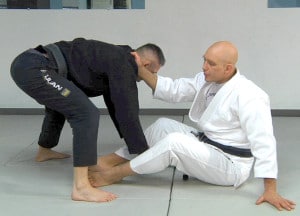
Sit up and grip his right lapel with your right hand. Your left hand is on the ground for support.
Now you’re going to do two things simultaneously: 1) quickly hop your hips to your left, and 2) powerfully pull his lapel towards you.
Essentially you’re going to pull him right down on top of you, but then move out of the way at the very last minute so he falls on his face.
Typically your opponent will end up basing his hands on the floor to protect his face (which frees up your legs and allows you to take his back – illustrated above), or will fall forward and then quickly roll onto his back (which allows you to get on top and work to pass his guard).
But even if you don’t manage to take his back or scramble to the top then he’ll almost certainly need his hands to base on the floor, and that means that you’ve solved the problem of the grips, haven’t you?
The big mistake with this move is only pull your opponent forward without displacing your body sideways at the same time.
First of all, it just pulls his body onto yours, which allows him to base on you and also smothers your movement.
Secondly the sideways movement of your body takes his arms out of alignment. Because your hips and legs move to the side his arms also get pulled to the side. This means that he can no longer support himself against getting pulled forward as effectively, which vastly increases the odds that he’s going to fall on his face.
Thirdly by involving the displacement and rotation of your hips you can generate MUCH more power than you can by simply using your arms.
Rather than listen to me, test it for yourself! Pair up with at training partner and take turns yanking each other forward with and without the simultaneous hip shift to the side.
I think you’ll find the hip shift makes a HUGE difference.
On a final note about this technique, I once taught this move once and someone blurted out that they didn’t like techniques that require a gi grip to work. The objection was, “I don’t want to train myself on gripping cloth to make techniques work.”
While I sympathise with wanting to have a mostly universal game – one that translates smoothly between gi and no gi – religiously avoiding grabbing cloth under all circumstances is a bit silly.
To quote Brandon Mullins, “…if there’s a gi-specific problem, you shouldn’t be afraid of picking a gi-specific answer.”
He’s creating the problem by gripping your pants, so it’s perfectly OK to solve that problem by gripping his lapel.
(Plus the leg and body movement you’re going to use in this technique will carry over almost exactly to the arm drag, which is a very similar technique that works both with and without the gi).
Toreando Counter 3 – The Arm Drag
The previous technique (the lapel drag) obviously relied on getting a good grip on your opponent’s lapel. With your hand securely anchored you then haul him to the mat or force him to release your legs.
But what about in no gi when you can’t anchor your hand on his lapel? No problem…
Use the arm drag instead!
By getting the arm drag grip you take one of his arms out of commission and also create a strong anchor point you can use to manipulate his balance.
Check out the video below to see how this might work against an early stage of your opponent getting double leg control, and/or check out The BJJ Arm Drag article for a comprehensive breakdown of this ultra-versatile attack!
Toreando Counter 4 – The Situp and Stiffarm
OK, let’s say you were just a fraction of second too slow, and now your opponent is 90% of the way past your legs.
Should you give up and concede side mount?
Not at all! Rage, rage against the dying of the fight!
In the video below called ‘Black Belt Guard Passing and Counter Techniques’ Elliott Bayev and I demonstrate the Leg Shuck guard pass and the counters to this type of pass.
The situp and arm push counter shown in this video – the very first technique shown in this video – can easily be be adapted to defend against the Toreando.
Stay sitting up. Secure a grip on one of his sleeves, turn away and maintain a straight arm to keep his weight off of you,
At this point you can shrimp away and replace your guard, but if your opponent prevents you from doing this you also have options to use the Granby roll and several other levels of defense to stop him from passing your guard.
The counters and recounters here get pretty intricate, so I would suggest watching the video below.
Three More Torreando Pass Counters
In the video below my friend and BJJ black belt Thomas Lisboa shows his approach to countering the Toreando guard pass.
If you watch it you’ll see that there are some similarities to the techniques above but also some differences. Jiu-jitsu is such an individual sport!
Fortunately you DON’T need to master every technique out there; instead become familiar with all the major options and then choose the ones that work for your body and style of rolling.
Check it out!
Good luck with your training!
Stephan
Additional Guard Retention Resources
If you’re interested in learning more about shutting down your opponent’s guard passes then I highly recommend The Guard Retention Formula instructional.
Click here for more information about The Guard Retention Formula, the detailed instructional on how you can make it really, really difficult for your opponent to pass your guard and give you the confidence to attack from the bottom knowing that you can recover no matter what happens.
The post How to Counter the Toreando Guard Pass appeared first on Grapplearts.


